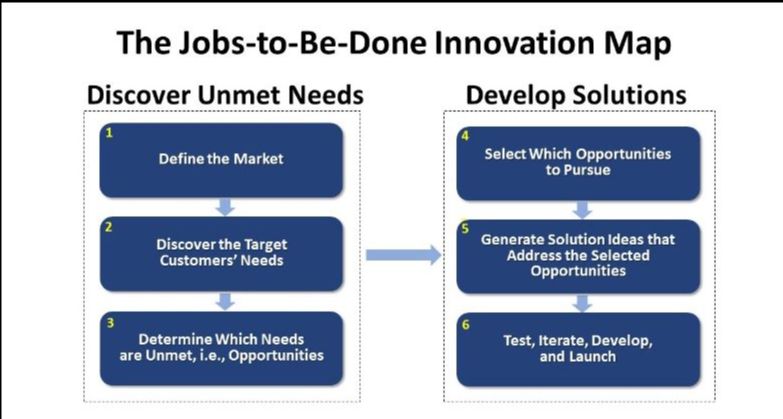How to Differentiate and Grow with the JTBD Innovation Map (Part 2)
Our clients don’t hire us because JTBD is the “new thing.” They hire us because we give them the highest likelihood of achieving their growth objectives with the least chance of something going wrong that could hurt them or their business. I hope this brief overview of the process as laid out in the JTBD Innovation Map will give you some simple, practical insights that you can put into action tomorrow.
In my last article, How to Differentiate and Grow with the JTBD Innovation Map (Part 1), I illustrated how anyone can differentiate and grow when they have a reliable process: first, discover your target customers’ unmet needs and then develop solutions to address them.
Many companies don’t have a reliable innovation process and that inevitably leads to high failure rates, a lot of frustration, wasted time and resources, opportunity costs, and even reputation damage – all of which are unnecessary. It pains me to see this because it’s a fixable problem.
The process outlined in the JTBD Innovation Map is the same process that I have used to help dozens of clients achieve their growth goals including:
•NetJets, the fourth largest airline in the world, to create a new business-centric service for C-level executives who travel frequently for work.
•Can-Am, a leading manufacturer of side-by-side off-road vehicles, to upgrade its product line including 9 different vehicle platforms and over 70 models.
•GBQ Partners, a regional accounting/consulting firm, to create new service offerings, make a strategic acquisition, and a joint venture with a talent management firm.
•And many other smaller enterprises as well.
Last time, we looked at the first three steps in the process (all part of discovering your target customers’ unmet needs). Today, I’d like to share how you can execute the last three steps to develop solutions that consistently win in the marketplace.
Just to review, the JTBD Innovation Map is based on this simple definition of innovation:
“Innovation is the process of discovering your target customers’ unmet needs and then developing solutions to address them.”
Figure 1.

Remember, job maps are different from customer journey maps. A customer journey map documents the steps customers go through when locating, selecting, acquiring, and using a firm’s product or service. Job maps, on the other hand, identify the steps customers must go through to get a job done independent of any product or service solution.
Develop Solutions
4. Select Which Opportunities to Pursue
The output from Step 3 is a ranked list of the opportunities in the target market. The customer needs are stated as functional, emotional, and social jobs to be done and the criteria customers use to measure success when executing the steps in the main functional job. These “need” statements are free of any product or service solution language which ensures that you won’t be constrained by current products and services. This increases the likelihood of breakthrough innovation.
Even though the findings from Step 3 may identify a dozen or more excellent opportunities in the market, not all of the opportunities will be attractive to pursue. That’s because the market is defined by the target customers and the job(s) they’re trying to get done – not by product or service categories. Hence, it’s not unusual for competitors in different product categories to be better suited to address some of the top opportunities.
For example, GBQ Partners, a regional accounting and consulting firm, found that some of the top 10 opportunities would be best addressed with a software solution. Hence, software tax prep companies like Intuit would quickly dominate the opportunity even if GBQ were the first mover.
To select which opportunities to pursue, evaluate each opportunity for its attractiveness based on how well you think your firm can address it and win in the market. Some common evaluation criteria are strategic fit, size of the revenue opportunity, relative advantage, time-to-commercialize, etc.
Great new products and growth strategies are formulated by addressing big market opportunities with the organization’s relative strengths, so that’s exactly what we’re doing here in a systematic manner.
But the evaluation of each opportunity goes one step further: it also determines the best way to address the most attractive opportunities. That can include any of the following:
- New or improved offerings
- Mergers or acquisitions
- Partnerships
- Operations alignment
- Messaging and positioning
- Any combination of these
Going through this exercise enables executives to better answer the two most important strategy questions every leadership team must address:
• Where will we play? What markets should we pursue? What product categories? What customer segments?
• How will we win? Given the nature of the opportunity and our relative strengths, should we build or buy new products/services? Or align operations with the customers’ jobs to be done? How can we establish a valued and unique position in our chosen market(s)?
Having these conversations informed by the unique JTBD insights enables leaders to start formulating their growth strategy and/or new product roadmap with confidence and clarity. You’ll have an unprecedented strategic view of the market.
JTBD also has the added benefit of aligning the executive leadership team, Board, and virtually all internal functional teams around the best opportunities because the opportunities have been identified by target customers, not by the often-dysfunctional politicking that can derail innovation initiatives.
5. Generate Solution Ideas to Address the Selected Opportunities
At this point in the process, you will have already identified and validated the opportunities in the market, and evaluated and selected those opportunities that are most attractive to pursue based on your firm’s ability to address them and win. So, now you are prepared to generate solution ideas with clarity and confidence because you’ll know where to focus and what you have to do to create unique value. Knowing where to focus your creativity makes all the difference in the world.
JTBD is a predictive theory which means, if you can help your target customers get their jobs and/or criteria done significantly better than the competition, then you can be confident that your target customers will value your new or improved offering.
6. Test, Develop, Iterate, and Launch
Because the opportunities in the market (important unsatisfied customer needs) have already been validated during Steps 1-3, it won’t be necessary to run experiments to validate customer needs. This eliminates the all-too-common confounding practice of running two experiments at the same time: one attempting to test the customers’ unmet needs and another attempting to test your solution’s efficacy.
Because the customers’ important unsatisfied needs have already been validated, you can test the efficacy of your new solution ideas alone. This enhances learning, reduces the number of iterations in development, and shortens the time to market.
“Failing fast” is often most effective after the market needs have been validated precisely because you won’t conflate two different experiments and end up running endless iterations trying to guess what combination of features will resonate with which customer needs. Steve Jobs understood the importance of first validating the target customers’ unmet needs:
“You’ve got to start with the customer experience and work backwards to the technology. You can’t start with the technology and try to figure out where you’re going to sell it.” – Steve Jobs (YouTube Clip)
Thomas Edison also understood the importance of validating the customers’ unmet needs before running experiments. Most people don’t realize that he only conducted experiments after he validated the market opportunity. Early in his career, after wasting time and money developing a product that his target customers did not want, he vowed to:
“…never again invent something without first knowing there was a need for it.”
(For more details, see Are You Making Anything Usable? Does Anyone Care? (Part 3), Forbes).
Summary
JTBD integrates the best of qualitative and quantitative research methodologies to provide game-changing insights. JTBD is unique in its ability to speak the language of both business and design.
It speaks the language of business by clearly identifying the target customers’ unmet needs (opportunities) before asking leadership to fund the development of any solutions. This significantly reduces the risk of misunderstanding the target customers’ needs and enables the firm to develop business cases that justify the funding of innovation projects. With JTBD, you don’t have to “increase your tolerance for risk” to be successful at innovation.
JTBD also speaks the language of design by revealing the target customers’ unmet needs (opportunities) in a format that is ideal for designers seeking to develop new and improved offerings that customers will want. The best creativity trigger is a well-defined customer need.
Bottom line: JTBD turns innovation and growth into a repeatable business process. Here are 12 ways it can help you consistently differentiate and grow:
1. Identify and rank the opportunities in your market so you can focus your creativity on what matters most to customers.
2. Avoid pursuing a target market that is too small to achieve your revenue objectives.
3. Avoid wasting time and money pursuing unimportant and/or already-satisfied needs. (They cannot deliver any competitive advantage).
4. Kill bad ideas quickly. (Any idea that does not target an important unsatisfied need is a “bad” idea). (For more details, see Why It’s Hard for Companies to Kill Bad Innovation Projects).
5. Unclog the front end of your new product pipeline and free up resources by entering only good ideas, i.e., ideas that address important unsatisfied needs.
6. Find and capitalize on hidden segments of opportunity that competitors don’t even know about.
7. Reduce the number of iterations in product development, enhance learning, and quicken the time to market.
8. Increase the effectiveness of your marketing, messaging, and positioning.
9. Gain alignment among the executive leadership, Board, and employees based on the value of the opportunities, not based on politicking.
10. Reduce the market risk of innovation – i.e., the risk that people won’t buy what you make – and thereby increase success rates.
11. Increase the size of your successes (monetary value).
12. Increase market share.
There you have it – the six steps to turning innovation and growth into a repeatable business process! Have you found the JTBD Innovation map useful? Can execute the steps on your own to some degree even if you’re not a JTBD practitioner to get significant value from it? Let me know. I appreciate your feedback, questions, and comments!
Read my previous article: How to Differentiate and Grow with the JTBD Innovation Map (Part 1)
New Offering
Did you know that I now offer an interactive executive learning experience on “Revenue Generation Through New Value Creation” for senior leadership and innovation teams? Learn how companies are flipping the script, changing the game, and achieving dramatically better innovation results with JTBD. You can, too!




